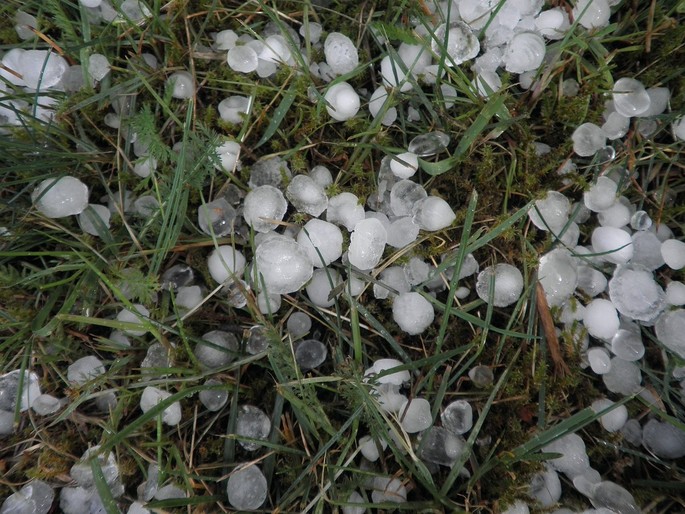The weather experts' forecasts have started to materialise: the first hailstorms have hit cars in various parts of Europe, damaging them in different ways depending on the area. The situation, however, is set to worsen in the short term - increasingly violent and sudden hailstorms will hit the Belpaese and getting organised and ready will be increasingly crucial.
In short, an unpredictable summer awaits us.
But let's rewind the tape: how did it go last year?
Hail in 2022
The year 2022 will be remembered as 'the year of hail' in Europe. This year, in fact, unprecedented hail events caused higher-than-expected losses and compensation in many European countries, especially in France. The losses, totalling billions of euros, overturned current knowledge of the average annual losses due to severe convective storms in Europe. Severe convective storms generally produce heavy rainfall and frequent lightning strikes. If a storm is intense enough - and weather conditions are in balance to make these storms intense - it can also produce large and damaging hailstorms, strong winds and even tornadoes.
Looking back to 2022, the total number of severe convective storm events increased significantly. There were 15170 reports of hail, wind, tornadoes and lightning, a 49.1 per cent increase over the five-year average. With an annual average of 3,275 hail events. In short, it is clear that while there is a modest increase in strong winds and lightning, hail is the main driver of severe convective storm reports in 2022, more than doubling the five-year average. A disaster for local and national economies, as well as for private finances. And the consequences are still evident today, with many cars still waiting to be repaired many months later.
What can we expect this year? Can we prepare ourselves?
Forecast for 2023
Hailstorms are predicted to be even more frequent, unpredictable and intense in 2023. With what consequence for the automotive sector? Even more damaged vehicles, more flooded car bodies and distressed car fleets. The severe temperature fluctuations that already occurred last year - causing a devastating hailstorm in June with hailstones of considerable size in some parts of the continent- could be repeated even earlier in this 2023, extending to other areas and especially extending well beyond the month of August.
Dealers: how to prepare?
Hail phenomena do damage without distinction, creating problems for everyone, from the private citizen with his utility car to the producer who sees his harvest mowed down. One particularly exposed category, however, is car fleets and large dealerships, as a single hailstorm can damage their entire fleet with dozens or hundreds of damaged cars. A severe blow to any line of business!
Moreover, not all dealers have always had to deal with hail damage, and in any case massive hailstorms such as those predicted for the coming months can completely paralyse their operations with dangerous economic repercussions that are difficult to contain.
The mistakes to avoid
EuoHailstorm, a multinational company that is one of the most important in the hail sector, has worked together with its dealer customers to draw up a short handbook containing some advice on "the mistakes to avoid in the first few hours after a hailstorm" when managing a park. Avoiding these mistakes, some of which are quite common and even understandable in the frenzy of the emergency, can minimise economic damage. It is precisely in critical situations such as these that it is essential to react in the most correct manner already in the first hours immediately following a hailstorm. 'Prevention is better than cure' is not just a proverb, but a good organisational practice that can avert serious economic repercussions such as those resulting from an immobilised car fleet due to damaged cars that cannot be sold. Therefore, avoiding mistakes or negligence will guarantee a significant competitive advantage even against competitors.
Time
'A hasty cat makes blind children'. What does this other proverb have to do with a post hailstorm? If not everything, a lot. The time factor is one of the most important in the immediate aftermath of a hailstorm, but it can be a double-edged sword. While it is essential to act immediately because a blocked car fleet makes all customers angry if the cars are already sold - and a buyer will obviously never accept a damaged car - and paralyses the fleet's operations with very serious economic repercussions, it is also true that relying on 'the first available dent remover' can represent an even greater risk.
Saving vs quality
A very similar issue is price, since choosing a team of technicians solely on the basis of this - desperately trying to minimise repair costs - can lead to entrusting your cars to inexperienced, superficial figures or those lacking first-class working tools. The end result, as in the previous case, is to end up with roughly repaired cars with visible bodywork imperfections that would very easily not be accepted by a buyer. Pay due attention, therefore, to the value of the labour you hire for repairs, remembering to evaluate ALL three basic parameters: quality, cost, time.
Reliability
So how do you choose a reliable contractor? Quite simply, even a simple internet search - as long as it is careful and thorough - can help you understand whether a company is professional or not. Customer reviews and insider ratings are always good clues, as they are based on the direct experience of those who have dealt with them. But also elements such as professionalism in corporate image and reputation are indications of seriousness and quality orientation. Always do the appropriate checks, you will not regret it.
Final Check
An equally important piece of advice, which may seem obvious but which in times of emergency may not be taken sufficiently into account, is to pay close attention to the final check. A serious and reliable repairer is used to re-examining cars after they have been repaired and providing the photographic material. Not having an inspection tool in place can lead to the risk of not realising immediately that repairs are inadequate and thus to an escalation of problems. For example, cars repaired several times with disproportionate overall costs, exaggerated timeframes and consequent complaints from buyers. If the repairer does not guarantee the final inspection, take the time to do the necessary checks yourself, in the end, because it is always worth it.















